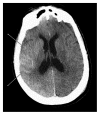A Seizure and Hemiplegia following Contrast Exposure: Understanding Contrast-Induced Encephalopathy
- PMID: 29686712
- PMCID: PMC5857315
- DOI: 10.1155/2018/9278526
A Seizure and Hemiplegia following Contrast Exposure: Understanding Contrast-Induced Encephalopathy
Abstract
Contrast-induced encephalopathy is a rare, reversible phenomenon known to occur after intravenous or intra-arterial contrast exposure. This report describes a case involving a 73-year-old female admitted for an elective thoracic aortic aneurysm repair. During the procedure, a large volume of nonionic iodinated contrast was necessary for arteriography. Postoperatively, the patient developed seizure activity followed by left-sided hemiplegia. Computed tomography (CT) of the brain without contrast and magnetic resonance imaging (MRI) were negative for acute stroke but did show residual contrast surrounding the brain. Antiepileptic medications were administered with resolution of the seizure activity. The patient was treated with supportive management and improved to baseline over the next seven days. This case demonstrates a rare, nonionic iodinated contrast-induced encephalopathy with seizure activity and transient hemiplegia. The unique imaging findings differentiate it from other neurologic conditions.
Figures




References
Publication types
LinkOut - more resources
Full Text Sources
Other Literature Sources

